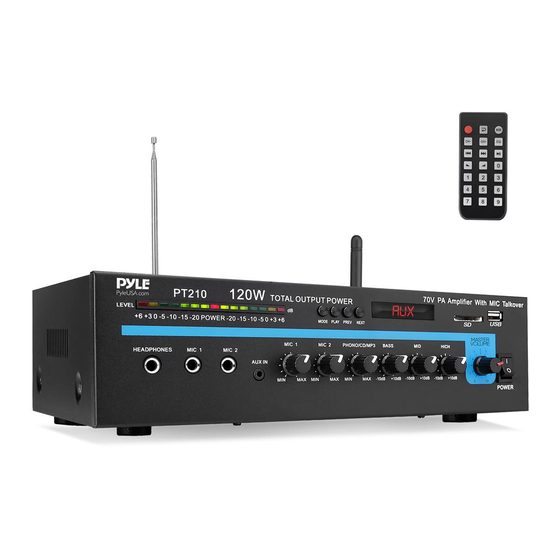Advertisement
Quick Links
Advertisement

Summary of Contents for Pyle PT210
- Page 1 PT210 120 Watt Microphone PA Mono Amplifier with USB/SD/FM/ Wireless BT 70V Output & Mic Talkover...
-
Page 2: Front Panel
INTRODUCTION Your New PYLE PT210 PA AMPLIFIER gives you the power and versatility you need in a professional sound system. The ampli er's wide frequency response makes it suitable for amplifying music or vocal program material. It can be used for live bands, o ce paging systems, public announcements, or a variety of other installations. - Page 3 21. PHONO and AUX/CD Input Selector: Lets you select the input source you want to connect to the ampli er. 22. MIX BUS Jack: Allows you to connect another PT210 to this jack to double the size of your PA system.
- Page 4 GND terminal, to avoid a low frequency hum. You can also use this screw to ground any other system connection. Input connections The PT210 accept a board range of input sources, including: • Microphones (up to two simultaneously) • Compact Disc (CD) player •...
- Page 5 Connecting a turntable In this Situation, set the PHONO and AUX/CD SELECTOR switch to the PHONO. Turntable Set the switch to the PHONO Position Speaker Connections One or more speakers (4, 8, or 16-Ohm) speakers can be connected to the ampli er with or without transformers.
- Page 6 System 2: Two (or more) speakers in series 1. Connect the LEFT SPEAKER (-) to the ampli er COMMON terminal. 2. Connect the LEFT SPEAKER (+) to the RIGHT SPEAKER (-). 3. Connect the RIGHT SPEAKER (+) to the ampli er's 4-Ohm, 8-Ohm, or 16-Ohm terminal, depending on the TOTAL IMPEDANCE of the two speakers.
- Page 7 This example shows two 8 Ohm Speaker, the total impedance is 4 Ohms. Left Speaker Right Speaker System 4: Four speakers in series/parallel combination 1. Group the four speakers into two pairs. 2. Connect each pair of speakers in SERIES (see system 2 above). If you connect 8-ohm speakers, the total impedance of each pair is 16 ohms.
- Page 8 This example shows four 8 Ohm Speaker, the total impedance is 8 Ohms. SERIES/PARALLEL VARIATIONS Although the description above is for combining TWO SERIES PAIRS in a PARALLEL hook up, you may also select to combine a SERIES PAIR and a PARALLEL PAIR in a PARALLEL hook up.
- Page 9 Four 8 Ohm Speakers This example shows for the rst three systems in chart. In this case, 4-Ohm terminal is used your system impedance may be varied depending on the impedances of the individual speakers, and may reguire hook up to the 8 or 16 Ohms terminal. System 5: Connecting speakers with transformers 1.
- Page 10 0.62 1.25 4 Ohm 10w Speaker (watts) (ohms) Using Headphones To listen privately, or to monitor sound sources, connect a pair of low impedance stereo headphones (not supplied) with 6.35mm plug into the PHONES jack on the ampli er front panel. Please listen safely.
- Page 11 Using the MIX BUS jack You can connect another PT210 to this jack to double the size of your PA system. This lets you use up to four microphones and two turntables (or two auxiliaryies) sound souces. Use a shield cable with phono plugs at each end, and connect the cable between the MIX BUS jacks on the back of two ampli ers.
- Page 12 Remote control 1. Press this button to turn on the MP3 2. In FM mode, press this two buttons to select previous or next channel. 3. Press these two buttons to select the previous or next track in USB or SD or Wireless BT mode 4.
- Page 13 • Voltage Selector 110/220V • Removable AC Cord • Unswitched AC Outlet • Mix Bus Jacks • Phono/Aux/RCA Input Jacks • Phono/Aux Input Selector • Variety of Speaker Outputs Terminal Wireless BT Connectivity: • Built-in Wireless BT Music Streaming Receiver •...
- Page 14 Questions? Issues? We are here to help! Phone: (1) 718-535-1800 Email: support@pyleusa.com...
















Need help?
Do you have a question about the PT210 and is the answer not in the manual?
Questions and answers